
by Matthew Orwat | Oct 21, 2016
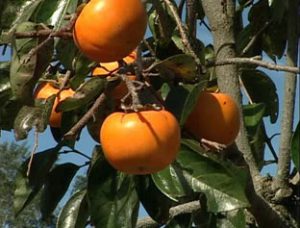
Image Credit: gardeningsolutions.ifas.ufl.edu
A recent visit to the North Florida Research and Education Center reminded me of a fruit that is often low profile in Northwest Florida, the Oriental persimmon. The Oriental, or Japanese, persimmon (Diospyros kaki) was introduced to the Southern United States in the mid to late 1800s. Although it is native to Japan and China, it is a close relative of the native persimmon Diospyros virginiana.
In the early 20th century the oriental persimmon was a popular fruit crop in Florida, but this industry declined due to marketing factors. The Oriental persimmon is still a viable fruit for home gardens.
Trees are available grafted onto local native persimmon rootstock, which enhances their ability to perform well in Northwest Florida soils.
Persimmons are divided into two types for the purposes of marketing: astringent and non-astringent. Astringent persimmons contain high concentrations of tannins which cause the mouth to pucker when eating the persimmon if it is not fully ripe. When fully ripe, they are rich and sweet, but very soft. Non-astringent cultivars can be picked hard and ripened for 7-10 days at room temperature. Non-astringent persimmons were developed in Japan and introduced to the U.S. market in the 1980s. These have become very popular with home gardeners since they can be eaten when firm, and have a crunchy texture. Persimmons are popular today in Asian cuisine and as a dessert, since they contain sugars at levels between 15 and 25%.
Persimmons have relatively few pests in Northwest Florida when compared to other higher maintenance fruits such as peaches and plums. Fungal leaf spot caused by species of cercospora, alternaria and anthracnose can cause premature defoliation. Fungicidal sprays are useful in controlling these diseases if they are at high enough levels to cause tree injury. The stem and branch fungus Botrysphaeria dothidia will cause deep, elongated branch lesions similar to canker. These openings invite borers into the tree and can lead to loss of the limb structure. The best defense against this problem is a good offense; a healthy tree will be less likely to be attacked by this fungus. Dormant sprays of copper or sulfur based fungicides can also help reduce the incidence of all fungal diseases.
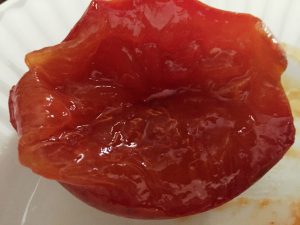
Fully ripe persimmon, ready for a scoop of ice cream! (Image Credit Matthew Orwat)
The major insect pest of persimmon is scale. Thankfully, scale can be controlled with dormant oil or season all horticultural oil. Persimmon psylla can cause leaf deformation early in the season, but is not always a large enough problem to warrant control. Natural enemies often eliminate the need for chemical control. If control is necessary, several insecticides labeled for fruit trees will take care of the problem. Twig girdlers can lay eggs on persimmon stems in September and October, and once hatched, the insect can girdle the stem and the stem will die. To control this pest it is important to remove dead and infected wood each growing season.
Out of the non-astringent cultivars, Fuyu regularly rates as the most popular and reliable cultivar. It does require thinning, since it often sets too much fruit, which can cause branches to bend and break. A good practice is to thin out 50% of the fruit during years in which fruit set is heavy.
Below is a chart of different non-astringent persimmon cultivar characteristics from the IFAS Extension publication SP 101, from April 1994 by E.P. Miller, Biologist; T.E. Crocker, Professor, Horticultural Sciences Department, Cooperative Extension Service, Institute of Food and Agricultural Sciences, University of Florida.
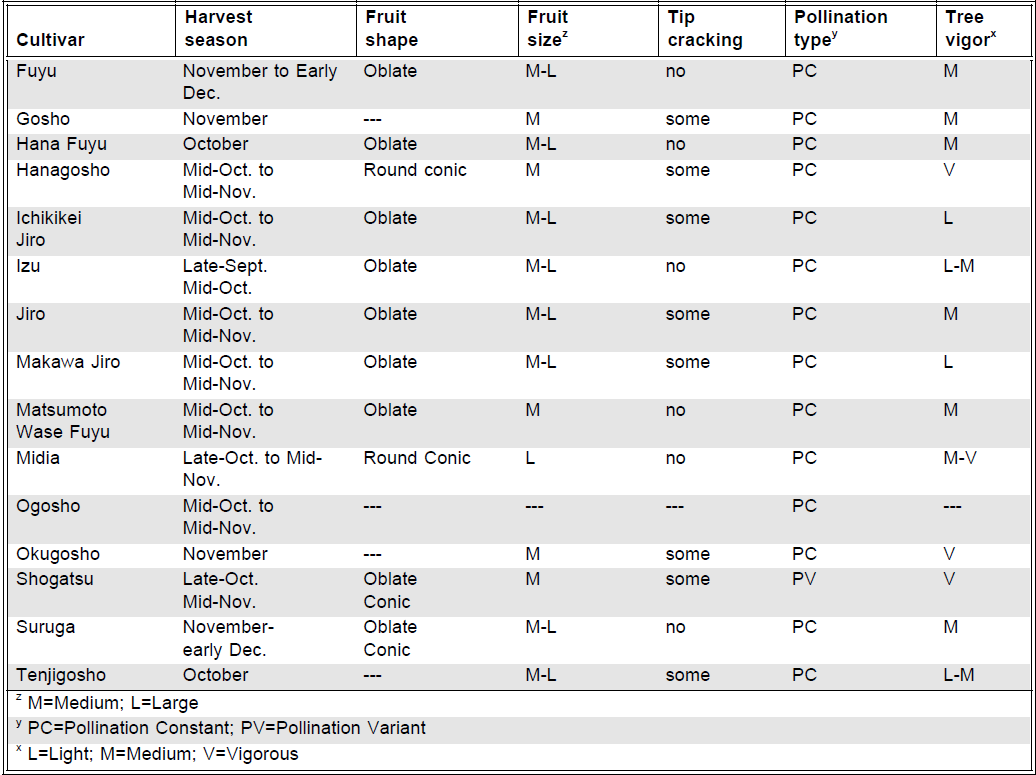
Characteristics of non-astringent cultivars. SP 101, from April 1994 by E.P. Miller; T.E. Crocker,
For further information please consult the UF / IFAS publication ENH 388: Diospyros kaki: Japanese Persimmon and the previous Panhandle Agriculture article Oriental Persimmon Varieties for North Florida .
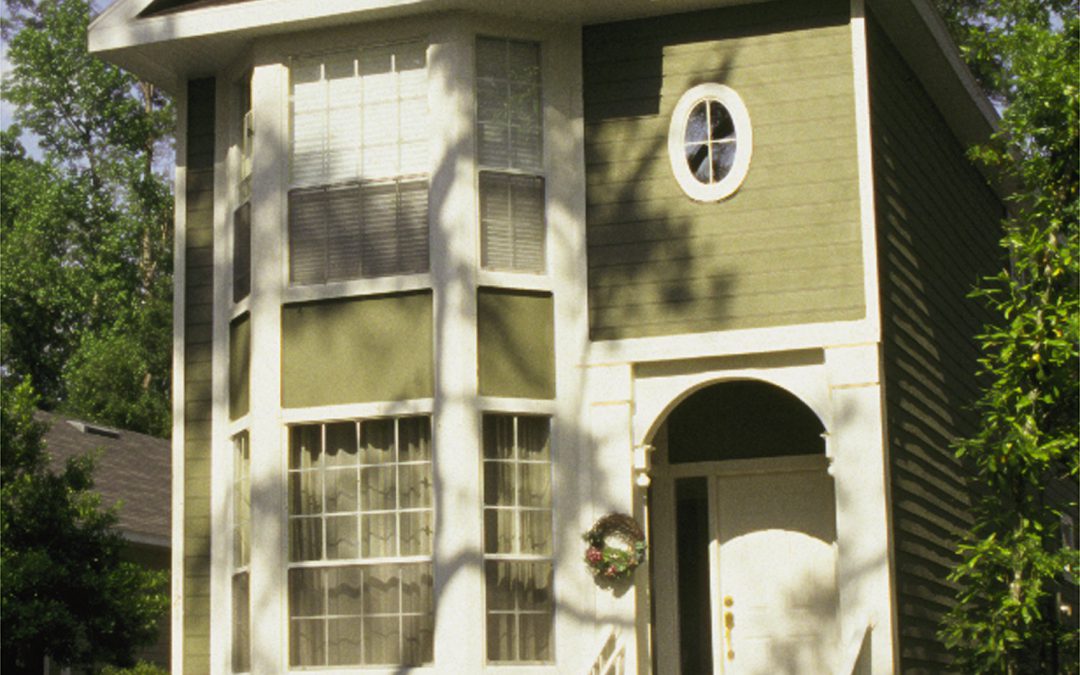
by Daniel J. Leonard | Sep 22, 2016
One of the most overlooked aspects of landscape design, particularly on DIY projects, is the idea of enhancing the architecture of your home by using plants that echo the shapes and features of the structure. The use of proper plant material not only shows off a home’s exterior beauty and increases curb appeal but often will translate into a significant boost in resale value! On site visits, I all too often encounter beautiful homes whose curb appeal potential is squashed due to poor plant selection. For example, how many times have you seen the ranch-style home with too-large Indica Azaleas across the foundation that are reaching for the eaves?
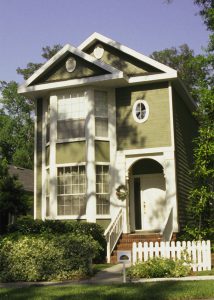
UF/IFAS File Photo.
Using plants to echo architecture is a pertinent topic for me as I just purchased a beautiful historic home in Walton County. This is a situation that could easily be ruined through improper plant selection. However, I’m going to try my best to use plants that enhance, not detract from, the architecture of the home. Here are a few very common architectural elements that happen to be present in my house and some easy planting tips to bring out the best in them:
- A steeply pitched roof and tall, narrow profile. A situation like this calls for the installation of a tight, upright shrub or tree to frame and echo the corner of the home. I am obeying this rule by planting a ‘Sioux’ crapemyrtle, a narrow, upright cultivar growing to 20’ and sporting flaming pink flowers. Some other plant options to consider installing: Ilex x attenuata ‘Savannah’ and other cultivars, ‘Apalachee’ crapemyrtle (lavender Flowers with cinnamon bark), ‘Brodie’ or ‘Spartan’ juniper (upright cultivars), ‘Little Gem’ magnolia. There are even a few selections of live oak such as ‘Highrise’, ‘Skyclimber’, etc. that fit the bill!
- Large, open front porch. We southerners love our front porch sitting, so don’t cover it up by planting large growing shrubs in front of it! Instead, plant a low growing, maintenance free ornamental grass or shrub! I decided to go with an airy, native look and fill the bed under my porch with pink muhly grass (Muhlenbergia capillaris). Here are a few other great options for a low growing plant to show off your porch: ‘Purple Pixie’ loropetalum (a new introduction from the Southern Living Plant Collection), dwarf Fakahatchee grass (an underused native), Indian hawthorne (overplanted but still effective), ‘Firepower’ nandina or one of its newer cousins (bulletproof with good fall color), ‘Soft Caress’ mahonia (elegant selection for a shady bed), holly fern (low growing evergreen fern for a shady area).
- Long, bare walls. Let’s face it, a blank wall is not visually pleasing and bare walls can actually act as a heat sink during our long summer afternoons! To break up the monotony of a bare wall and provide some shading for cooling purposes, mix plants of different heights and textures, even add a small tree or two! Here are a few reminders when landscaping to bring interest to a bare wall: Plant the taller plants (larger shrubs and small trees) in between windows to get height interest but not block views; use plants with flexible limbs and soft foliage for easy pruning and to make maintenance easier; choose plants with colors that will be compatible with the wall; finally, allow at least a foot or two between the wall and the mature size of your plants for ease of access! The plant choices for this application are endless. Get creative!
Whatever your house’s style may be, remember the above suggestions when planting and watch as your landscape grows to enhance the look and value of your home rather than detract from it! Happy planting!
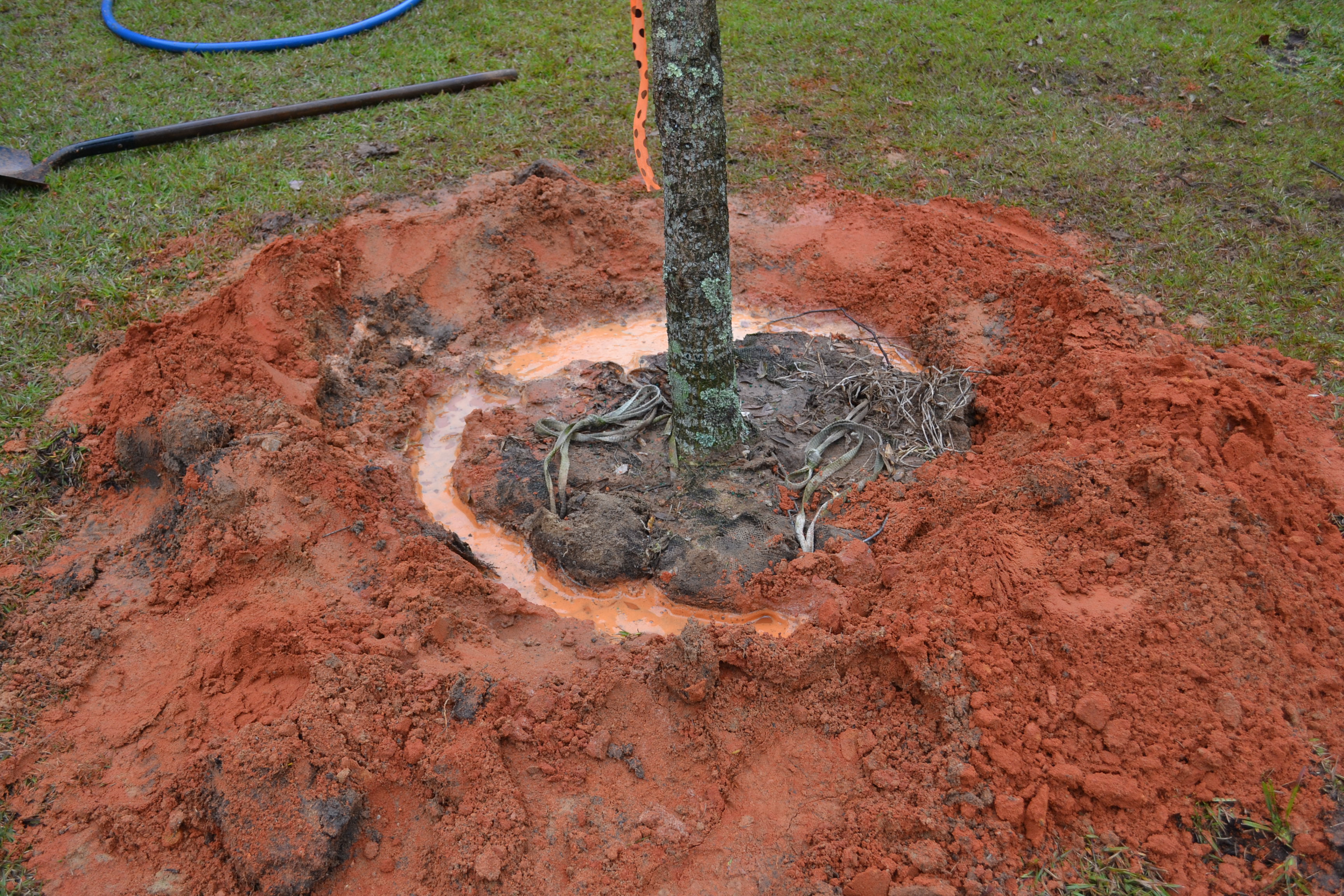
by Beth Bolles | Sep 8, 2016
By the look of the crowded nurseries during March and April, springtime seems to be the best time for planting. This is the case for our frost tender annuals and perennials but we are actually heading into our best seasons for planting trees and shrubs.
The fact that above ground portions of trees and shrubs go through a time of slowed growth or dormancy is the good reason for planting during the fall and winter. Although we don’t see it, roots are still growing slowly and the upcoming months give new plants the time for roots to spread into surrounding soil before hot temperatures return. Water stress is also not as significant during the cooler months. Plants still need to be supplied regular water but needs are not as high, especially if rainfall occurs.
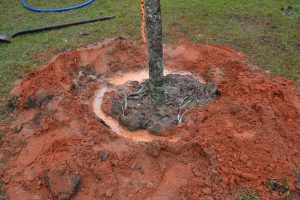
A tree installed in the cooler months has more time to establish before hot weather returns.
Start gathering your ideas for new or replacement trees and shrubs that will match your landscape and visit a local nursery this Fall.
If you need an update on tree and shrubs planting and care techniques read more in the UF IFAS publication.
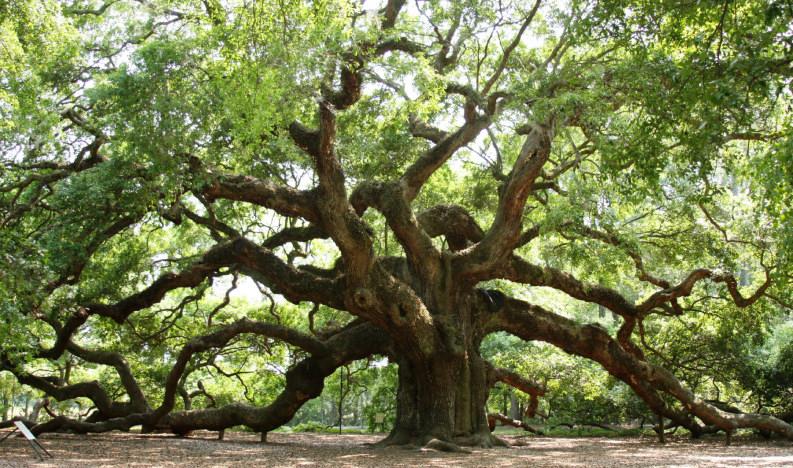
by Daniel J. Leonard | Jul 26, 2016
The Live Oak (Quercus virginiana) is one of the most iconic figures of the Deep South. Mentioning the words Live Oak invokes all sorts of romantic nostalgia of yesteryear and the reputation is not unearned. In fact, many Live Oaks still stand that were growing on American soil when the first English settlers set foot on Plymouth Rock. They are long-lived, picturesque trees that also happen to be nearly bulletproof in the landscape. Given these factors, it is not surprising that Live Oak is far and away the most common tree included in both residential and commercial landscapes in the Coastal South. However, even the venerable Live Oak is not without its problems; this article will discuss a few of the more common issues seen with this grand species.
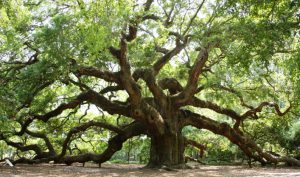
The Angel Oak near Charleston, SC
Few conditions afflict live oak but when they do, improper planting or cultural practices are usually at play. Observing the following best management practices will go a long way toward ensuring the long-term health of a planted Live Oak:
- Remember to always plant trees a little higher than the surrounding soil to prevent water standing around the trunk or soil piling up around it, both of these issues frequently cause rot to occur at the base of the tree.
- If planting a containerized tree, remember to score the rootball to prevent circling roots that will eventually girdle the tree. If planting a B&B (Balled and Burlap) specimen, remember to remove the strapping material from the top of the wire basket, failure to do this can also result in the tree being girdled.
Live Oak has few insect pests but there are some that prove bothersome to homeowners. The following are two of the most common pests of Live Oaks and how to manage them:

Typical galling on Live Oak
Galls are cancerous looking growths that appear on the leaves and twigs of Live Oak from time to time and are caused by gall wasps that visit the tree and lay their eggs inside the leaf or stem of the plant. The larvae hatch and emerge from the galls the following spring to continue the cycle. These galls are rarely more than aesthetically displeasing, however it is good practice to remove and destroy gall infected stems/leaves from younger trees as gall formation may cause some branch dieback or defoliation. Chemical control is rarely needed or practical (due to the very specific time the wasps are outside the tree and active) in a home landscape situation.
- Black Twig Borers can also be problematic. These little insects seldom kill a tree but their damage (reduction of growth and aesthetic harm) can be substantial. Infestations begin in the spring in Northwest Florida, with the female twig borer drilling a pen-head sized hole in a large twig or small branch and then laying her eggs in the ensuing cavity. She then transmits an ambrosia fungus that grows in the egg-cavity, providing food for the borer, other borer adults, and her offspring that take up residence and over-winter in the twig. The activity of the insects in the twig has an effect similar to girdling; the infected twig will rapidly brown and die, making removal and destruction of the infected branches a key component
In conclusion, though there are a few problems that can potentially arise with Live Oak, its premier status and continued widespread use in the landscape is warranted and encouraged. It should be remembered that, relative to most other candidates for shade trees in the landscape, Live Oak is extremely durable, long-lived, and one of most pest and disease free trees available. Happy growing!

by Daniel J. Leonard | Apr 27, 2016
People are, by nature, skeptical. Humans are and have always been questioners of the world around them and that’s a good thing! For instance, when one reads a sensational article on Facebook or watches an infomercial selling a too-good-to-be-true product he/she is immediately dubious of the veracity of the claim. Given this innate sense, why do consumers take plant tags displayed on retail plants and the information listed there as infallible fact when in reality they are often full of hyperbole and misleading?
I do not mean to insinuate that nurseries and landscape professionals are intentionally leading consumers astray. They are not. However, there is much incorrect information disseminated to consumers by the green industry on plant fact sheets. Take my titular example, ‘Little Gem’ magnolia is widely advertised and sold as a “dwarf” magnolia, only growing 15’-25’ tall. If given proper care, it will grow to that height…in seven to ten years. Given enough time, ‘Little Gem’ has will grow in excess of forty feet. People plant this cultivar under the eaves of single story houses on a regular basis! I promise that cute little magnolia you were told would grow 15’ tall will look rather silly when it is four times the height of your house. Take another example, how many times have you seen or heard of ‘Acoma’ crapemyrtle being sold as a “semi-dwarf” cultivar that grows to 10’ in height for use in a tight spot of the landscape in lieu of the much larger ‘Natchez’? It will fill that tight spot and fill it rather quickly. ‘Acoma’ can easily reach 20’ in height and width at maturity, engulfing its intended area.
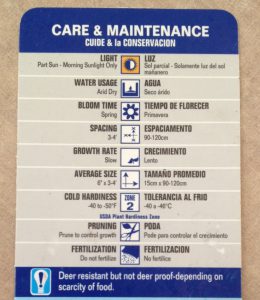
Typical plant tag. Notice the “Average Size” section. This is where consumers should use discretion.
So why does this happen? Why are plant tags so often mistaken? There are two primary reasons that correct mature sizes are not given. First, in the competitive world of plant breeding and introduction where there can be hundreds or thousands of cultivars of a single species, it is of utmost importance to introduce plants as quickly. Quick introduction is necessary because others are probably working to find similar traits; therefore, if one notices that a plant possesses a drastically different flower, flowering pattern, leaf shape, leaf size, or growth habit, the plant is often rushed to market. This leaves little time for complete trials of the plant to see what it would look like at maturity.
Secondly, most well-adapted or native trees/shrubs have relatively long life spans. A crapemyrtle or magnolia can easily grow and thrive in a landscape for thirty years or more before reaching maximum size. Nurseries simply do not have time to evaluate plants that long. Many nurseries, due to vagaries of economic cycles and length of career spans, don’t even exist for thirty years much less trial a single plant for that length of time!
In conclusion, nurseries are not likely to change their plant tag practices, but there are a couple of checks consumers can use to make sure they buy an appropriate plant for the scale of their site. First, it is a good rule of thumb to double the advertised plant height to arrive at a better idea of the plant’s mature size. Second, drive through established neighborhoods and observe what certain plants look like in a mature landscape. This will give one an idea of what the plant is capable of. The third and best option is to consult your local County Extension Office. They will be able to offer research-based information to help you make the right decision in your plant choices. Keep this in mind the next time you are thinking of buying the latest, greatest plant at your local nursery!
Happy Gardening!













